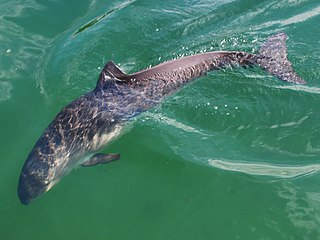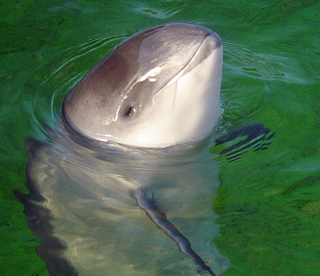
Porpoises are a group of fully aquatic marine mammals, all of which are classified under the family Phocoenidae, parvorder Odontoceti. Although similar in appearance to dolphins, they are more closely related to narwhals and belugas than to the true dolphins. There are eight extant species of porpoise, all among the smallest of the toothed whales. Porpoises are distinguished from dolphins by their flattened, spade-shaped teeth distinct from the conical teeth of dolphins, and lack of a pronounced beak, although some dolphins also lack a pronounced beak. Porpoises, and other cetaceans, belong to the clade Cetartiodactyla with even-toed ungulates.

Neophocaena is a genus of porpoise native to the Indian and Pacific oceans, as well as the freshwater habitats of the Yangtze River basin in China. They are commonly known as finless porpoises. Genetic studies indicate that Neophocaena is the most basal living member of the porpoise family.

Phocoena is a genus of porpoises with four extant species:

The harbour porpoise is one of eight extant species of porpoise. It is one of the smallest species of cetacean. As its name implies, it stays close to coastal areas or river estuaries, and as such, is the most familiar porpoise to whale watchers. This porpoise often ventures up rivers, and has been seen hundreds of kilometres from the sea. The harbour porpoise may be polytypic, with geographically distinct populations representing distinct races: P. p. phocoena in the North Atlantic and West Africa, P. p. relicta in the Black Sea and Sea of Azov, an unnamed population in the northwestern Pacific and P. p. vomerina in the northeastern Pacific.

Burmeister's porpoise is a species of porpoise endemic to the coast of South America. It was first described by Hermann Burmeister, for whom the species is named, in 1865.

Dall's porpoise is a species of porpoise endemic to the North Pacific. It is the largest of porpoises and the only member of the genus Phocoenoides. The species is named after American naturalist W. H. Dall.

Naval Air Station Whiting Field is a United States Navy base located near Milton, Florida, with some outlying fields near Navarre, Florida, in south and central Santa Rosa County, and is one of the Navy's two primary pilot training bases. NAS Whiting Field provides training for U.S. Navy, U.S. Marine Corps, Coast Guard, and Air Force student pilots, as well as those of several allied nations. NAS Whiting Field is home to Training Air Wing Five.

Frost Glacier is a channel glacier flowing to the head of Porpoise Bay, Antarctica. It was delineated from air photos taken by U.S. Navy Operation Highjump (1946–47), and named by the Advisory Committee on Antarctic Names for John Frost, boatswain on the brig Porpoise of the United States Exploring Expedition (1838–42) under Charles Wilkes.
Union Passage Marine Provincial Park is a provincial park within the asserted traditional territory of the Tsimshian First Nations. The marine protected area is located at the southwest end of Grenville Channel straddling Pitt and Farrant Islands, in British Columbia, Canada.

Porpoise Bay Provincial Park is a provincial park in British Columbia, Canada.
F-IRE Collective is a creative music community founded by Barak Schmool. It has been described as the UK's leading and perhaps most influential modern jazz group. The Collective also has a record label.
Thomas Raphael Moon is an American saxophonist, author, and music critic. He is known for his book 1,000 Recordings to Hear Before You Die. He has won two Deems Taylor Awards from the American Society of Composers, Authors and Publishers.

Infernal Machines is the debut studio album by Darcy James Argue's big band Secret Society. The album was released May 12, 2009 by New Amsterdam Records and was nominated for a Grammy Award.
The Ngugi are an Aboriginal Australian people, one of three Quandamooka peoples, and the traditional inhabitants of Moreton Island.
Archaeophocaena teshioensis is a species of extinct porpoise from the Late Miocene Koetoi Formation of Japan living around 6.4–5.5 million years ago (mya). The holotype specimen comprises a partial skull. The animal, along with Miophocaena and Pterophocaena, seem to represent an intermediary phase between porpoises and dolphins. The genus name derives from Ancient Greek archaeo, "ancient," and Latin phocaena, "porpoise"; the species name honors the Teshio District where the holotype was discovered.
Miophocaena nishinoi is an extinct species of porpoise from the Late Miocene Koetoi Formation of Japan, dating to around 6.4–5.5 million years ago (mya), represented by a partial skull. the genus name derives from Ancient Greek mio for the Miocene, and phocaena for "porpoise"; the species name honors the discoverer, Takanobu Nishino. Miophocaena resides in a clade with Archaeophocaena discovered in the same area, and, along with Pterophocaena, represents an intermediate phase between porpoises and dolphins.
Pterophocaena nishinoi is an extinct species of porpoise discovered in the Late Miocene Wakkanai Formation of Japan dating to 9.3–9.2 million years ago (mya), and may represent an intermediate phase between porpoises and dolphins. It is one of the oldest species discovered, after the Middle Miocene Loxolithax 16–14.8 mya and the Late Miocene Salumiphocaena 12.6–9 mya. The holotype specimen comprises a partial skeleton. The genus name derives from Ancient Greek pteryx, "wing," in reference to its unusually pronounced beak, and Latin phocaena, "porpoise." The species name honors the discoverer of the holotype, Takanobu Nishino.
The 1970 Western Kentucky football team represented Western Kentucky University during the 1970 NCAA College Division football season. The team was led by coach Jimmy Feix and won the Ohio Valley Conference championship after coming in second the previous three years. The coaching staff included future NFL coach Romeo Crennel. The Hilltoppers’ finished the season ranked No. 12 in the AP and No. 9 in the UPI final polls.
The 1945 SMU Mustangs football team was an American football team that represented Southern Methodist University (SMU) as a member of the Southwest Conference (SWC) during the 1945 college football season. In their eighth, non-consecutive season under head coach Matty Bell, the Mustangs compiled a 5–6 record and outscored opponents by a total of 201 to 110. After a stretch in which the team lost six of seven games, SMU finished the season with three consecutive shutout victories over Arkansas (21-0), Baylor (34-0), and TCU (34-0). The team played its home games at Ownby Stadium in the University Park suburb of Dallas.

The Yangtze finless porpoise is a species of toothed whale in the family Phocoenidae. It is endemic to the Yangtze River in China, making it the country's only known freshwater cetacean following the possible extinction of the baiji. The Yangtze finless porpoise is considered critically endangered and it is estimated that only about 1,000 remain. This small toothed whale faces many of the same threats that caused the baiji dolphin to possibly become extinct. The Yangtze River has a high traffic rate of human activity causing population declines due to illegal fishing, pollution, vessel traffic, and dam construction. Due to the rapidly declining population of the species, the Chinese Government and conservation charities are working to help save it from extinction.










